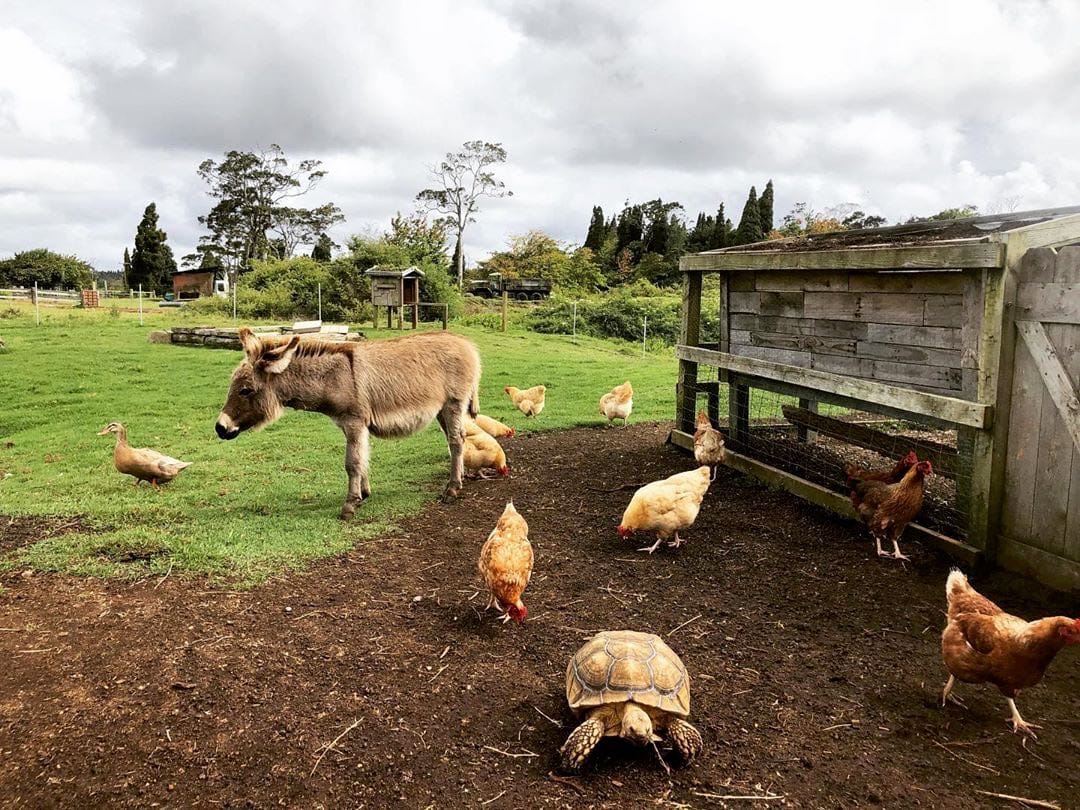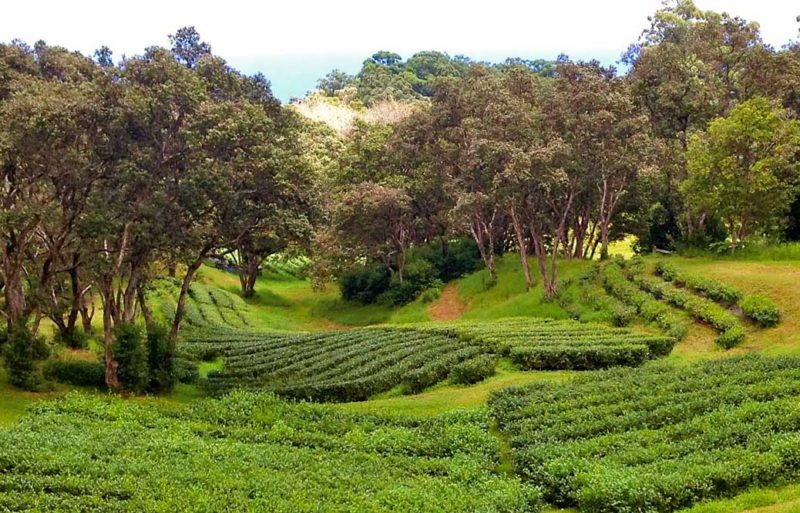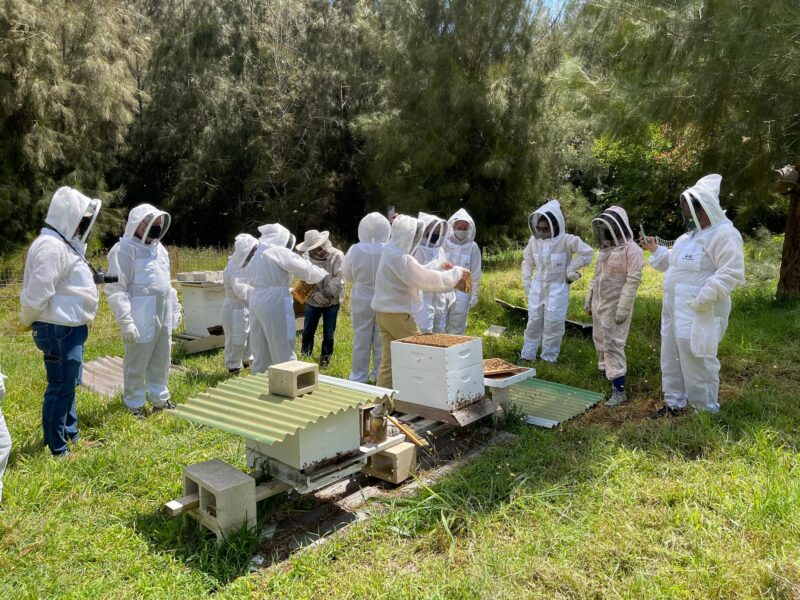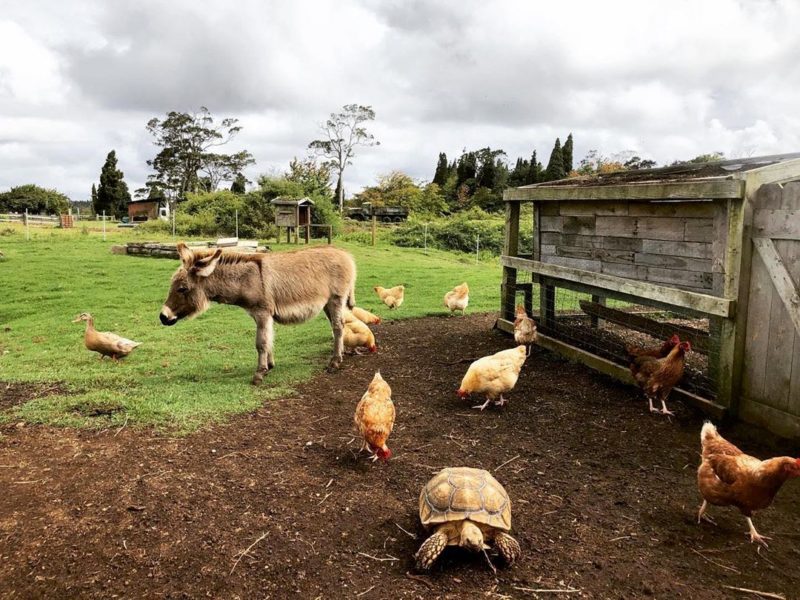The Hawaiian islands, with their volcanic soil and mild year-round climate, offer a fertile environment for our many different kinds of exotic farms. You can visit some of these farms for a tour to learn about what they grow and often enjoy a taste of what they have to offer.
We list the most popular farm tours and tastings + other agricultural tours (animal related tours, farmers markets) on the Big Island below:
Table of contents
- Map of all tours listed on this page
- Farm tours including locally produced goods
- Tours including exotic animals / animal shelters
- Native trees / tree planting
- Farmers markets (the best place to buy local produce)
- Farm to Table restaurants and Cooking Classes
- Eating from an Imu (Hawaiian underground oven)
- Introduction to local agriculture
Table of Contents
- Map of all tours listed on this page
- Farm tours including locally produced goods
- Tours including exotic animals / animal shelters
- Native trees / tree planting
- Farmers markets (the best place to buy local produce)
- Farm to Table restaurants and Cooking Classes
- Eating from an Imu (Hawaiian underground oven)
- Introduction to local agriculture
Do you want to bring produce home? While local products are fantastic souvenirs you should make sure you are allowed to bring them with you. Untreated fresh fruits and vegetables are in general not allowed, coffee and flower leis should be no problem. You can find a complete list of common items from Hawaii that are allowed into the U.S. mainland here.
Related: Culinary activities on Kauaʻi, Oʻahu and Maui
Are you planning to also visit other islands in the state and do you like our style? Then the following guides might be a good place to start your culinary trip planning:
- Culinary tours and activities on Kauaʻi
- Culinary tours and activities on Oʻahu
- List of farm tours on Maui
Map of Farm Tours:
We were happily surprised by the sheer amount of ways you can see our farms and sanctuaries up-close while putting together this resource. However, this abundance can make planning a visit confusing because the farms are spread out all over the island and, well, how are you going to find a tour that fits in with your itinerary?
To make planning your farm tour easier we summarized all tours listed on this page into one BIG map. Note that some addresses are approximate because not all farmers prefer to give out their exact address only after you have made a reservation.
How to use this map: Above you’ll find a map of all farm and related tours on the Big Island. Click on the top left of the map to find separate layers marking the route and points of interest. You can hide and show different layers, or click icons on the map to see more details for the places I mention in this guide. “Star” the map to save it to your own Google Maps, or open the map in a new window for a larger version. Enjoy!
Farm tours including locally produced goods:
We split our list of farm tours in places that grow things (this section) and in animal-related tours (next section):
- Tea plantation tours / tasting
- Coffee plantation tours /tastings
- Chocolate orchard tours / tastings
- Vanilla farm tours / tastings
- Macadamia nut orchard tours
- Taro farm tours in Waipiʻo Valley
- Misc. farm tours
- Volcano Winery (wine tasting)
- Hibiscus farm tour
You’ll notice that there are no ‘pineapple farm tours’ in the list. Pineapples are a disappearing crop and now are mostly grown on the islands of Maui and Oahu. The Big Island agricultural scene was up to a few decades ago dominated by the sugar cane industry, but that has also disappeared by now. Visit the Hawaii Plantation Museum in Papaikou to learn more about the rich history of the sugar plantation era.
Tea Farm tours + tastings
The Big Island is known for its coffee and coffee tasting but did you know that there are also tea plantations on Hawaii Island? Tea plants LOVE lots of rain, grow best at higher elevations, and need acidic soil with good drainage, lots of sunlight and moderate to high humidity. These factors all come together on the north-eastern side of the Big Island.
Tea is a labor-intensive crop and the local farmers aim for quality rather than quantity. They are mostly artisans using traditional and natural techniques that produce small batches and who cater to specialty markets. In short, if you really like tea you’ll REALLY like visiting one of our local tea plantations:
- Mauna Kea Tea (near Honokaʻa)
- Big Island Tea (between Hilo and Volcano Village)
- Tea Hawaii (in Volcano Village)
You can find more in-depth information about tea growing and tea tours on the Big Island on our website.
Coffee tour + tastings
Kona coffee is one of our most valuable and well-know export products. Coffee here in Hawaii grows best on a tropical, narrow, and extremely scenic strip on the slopes of the Hualalai and Mauna Loa volcanoes in the north and south Kona district. You can find more than 650 coffee farms of all sizes clustered along the ±20 miles of scenic roads covering these slopes, and many of these offer tours to the public.
Tours generally consist of a walk through the fields where you are given an explanation about growing coffee, a visit to the area where they process the beans, and a tasting. These tours give local farmers the opportunity to sell their coffee directly to their visitors, which is why the tours themselves often are free of charge. Two coffee farms that organize informative tours and serve delicious coffees are Rooster Farms and the Greenwell farms, both in South Kona.
You can find a WAY larger list (+ map) of farm tours at our list of farms that organize coffee tours and tastings.
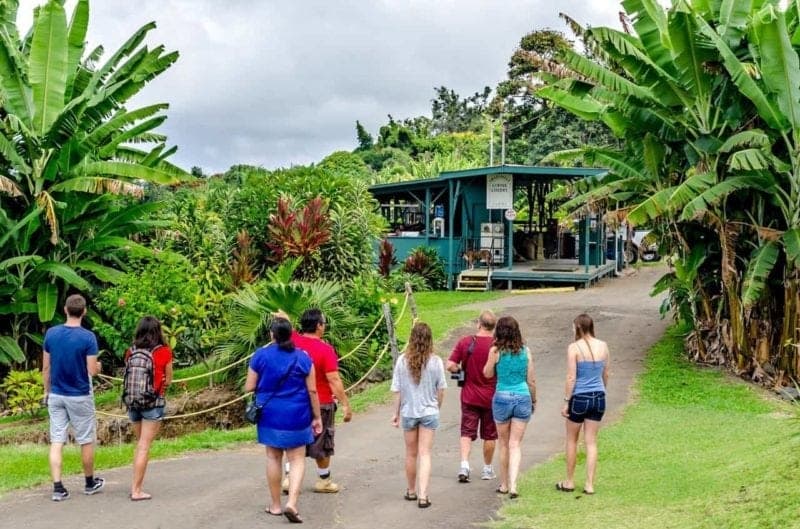
Visitors take a Kona Coffee Farm Tour at the Greenwell farm. Source: here by user horspowr1001 under a CC BY-NC 2.0 license
Chocolate Farm Tours + Tastings
Chocolate is one of Hawaiʻi’s most delicious but unknown export products. It also is a good souvenir to take home (chocolate covered macadamia nuts anyone?!)
Hawaii is the only state where chocolate can be made with 100% locally produced ingredients thanks to its tropical climate. Some of the farms that grow cacao pods organize tours of the orchards and tastings of their home-made chocolate. Examples of such tours are:
- Kuaiwi Farm in South Kona (website)
- Honokaa Chocolate Co. in Honokaʻa (website)
- Hamakua Chocolate in Papaikou (6 miles north of Hilo, website)
- Puna Gold Estate in Lelani Estates near the town of Pāhoa (website)
You can find more tours in the guide to locally produced chocolate on our website.
Vanilla Farms
Vanilla beans are the fruits of an orchid that blooms for one day only, during which the flower must very carefully be hand pollinated. There are many more fascinating things to learn about growing vanilla, which you can do during a tour of these two vanilla farms:
- The Hawaiian Vanilla Co. (close to Honokaʻa on the Hamakua coast) organizes farm tours that can also include a lunch during which you can taste foods and drinks that include their vanilla. You can book this tour here.
- The Vanillerie is a small vanilla farm just north of Kona. They organize tours through their greenhouses and let you taste their products. Find more information about the tours on their website.
Vanilla Experience Luncheon & Farm Tour
Experience a delicious vanilla inspired luncheon and walking tour through a Hawaiian vineyard with vanilla vines. Learn about the vanilla cultivation process and rich history while enjoying homemade vanilla offerings.
from:
$89.50
What is a suggested tour?Our suggested tours are hand-picked tours that receive consistent good reviews, give back to the community, and work hard to minimize their impact on the environment. Read more about these tours on our website.The following video about the tour + luncheon (see above) organized by the Hawaiian Vanilla Co. gives you an idea of what to expect during a visit:
Macadamia Nuts Orchard Tours
Macadamia nuts are one of Hawaiʻi’s export crops and they are delicious! You can find some small farm tours whose properties also contain macadamia nut orchards but there are no dedicated macadamia orchard tours on the Big Island. If you are looking to see a macadamia orchard you should have a look at more general-purpose farm tours listed here.
The farming and processing of macadamia nuts mostly is a large-scale operation and there are two companies that sell macadamia nuts with a visitor center you can visit:
- The Hamakua Macadamia Nut Company (in Kawaihae, north of Kona website)
- The Mauna Loa Macadamia Nut Corporation (close to Hilo, website)
Both above have visitor center where you can see how the nuts are processed and the Hamakua Macademia Nut Company also offers free samples and coffee at their visitor center. The Hamakua Mac nut company has a more local feel and is a good place to buy nuts.
You can read more about macadamia nuts on our website.
Wetland Taro (Kalo) farm tour in Waipiʻo Valley
Wetland taro (called ‘kalo’ in Hawaiian) is one of Hawaiʻi’s most iconic crops with a deep cultural connection to the Hawaiian way of life. The primary product made from taro and a staple in the Hawaiian diet is poi, which is made from the underground plant stem of that taro plant, while the taro leaves are used to prepare lau lau (explore more taro recipes or read more about taro farming on the Big Island).
Most taro on the Big Island is grown in Waipiʻo valley and the Hamakua districts, and you can visit a taro farm in Waipiʻo valley yourself as part of a guided tour. Organized by Hawea Waipiʻo Valley Adventure, this tour unfortunately was discontinued in 2020.
For those curious about eating poi: you can find it in local supermarkets such as the KTA and sometimes find it at the menu in restaurants and luaus. Poi has a paste-like texture with a pale purple color that naturally comes from the plant. Its taste greatly depends on freshness and preparation method but in general is not very outspoken.
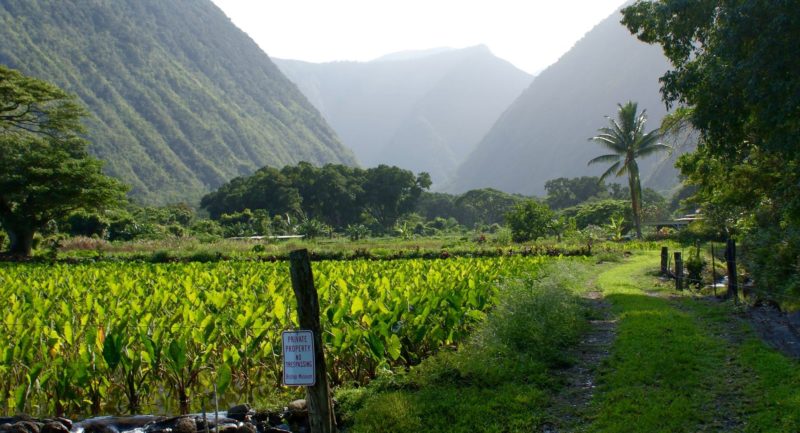
A wetland Taro field in Waipiʻo valley. Image credit: Shooting Chris on Flickr. Adapted from original.
‘General’ Farm Tours:
There are many small farms on the Big Island that grow a multitude of crops rather than specializing in just one. These are mostly organic farms using sustainable practices. Tours take you around their property while explaining why they do what they do, and afterwards there is a chance to sample their locally grown products. Some farms even organize full-blown farm-to-table dinners!
Pali Nana Farms
Pali Nana Farms is a 22-acre off-grid farm located on the Hamakua Coast. They specialize in growing and making chocolate, honey, and various exotic fruits, and are also a home to horses, cattle, miniature donkeys, and kunekune piglets. You can explore their farm by various means including hayrides and horse rides, both of which include your choice of delicious wood fired pizza. All tours are 3 hours long and also include a chocolate making demonstration and tasting.
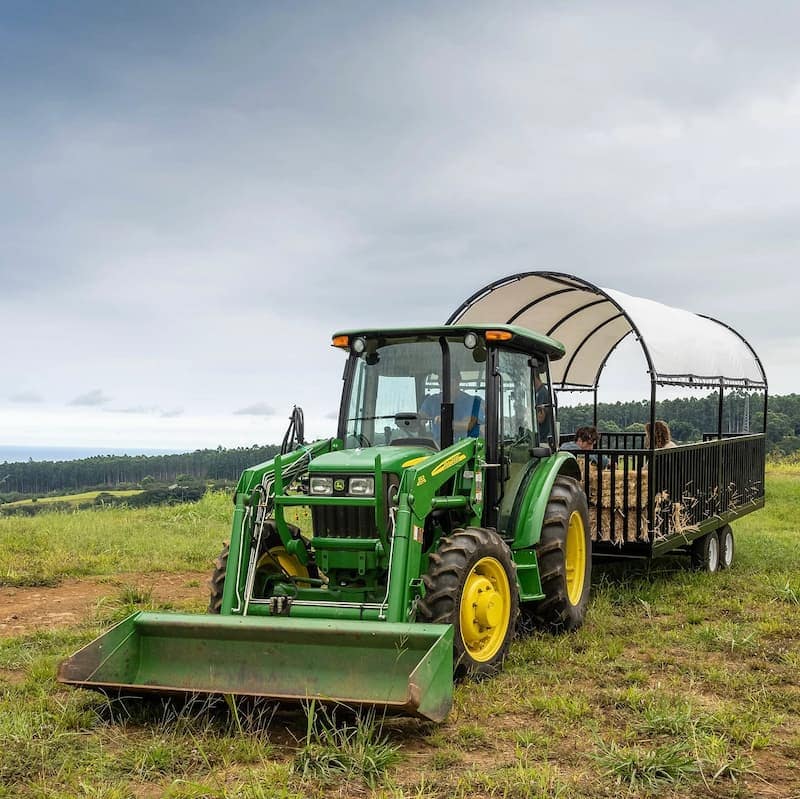
The Pali Nana farm tour includes a 90-minute in-depth walking tour and hayride of the farm. Image: the Pali Nana Farm.
Kuaiwi Farm
Kuaiwi farm is a five-acre certified organic farm in the south Kona district growing a diverse range of crops including Kona coffee, chocolate, macadamia nuts, avocados, bananas, pineapple, tea, citrus, vegetable gardens and more. Their ~2 hour farm tour includes a tasting of their products on the breezy lanai. Drink coffee, taste chocolate, apple bananas, mac nuts and chat with the geckos.
Starseed Ranch
The Starseed Ranch is a sustainable homestead and farm on the northern coast of the Big Island of Hawaiʻi, about 15 minutes from the historic town of Hawi. They organize a 1-hour tour through their 6-acre orchard with a variety of tropical fruit trees (mango, papaya, avocado, breadfruit, lemon, lime, coconut) and a tropical food forests planted with traditional Polynesian crops (kalo, turmeric, bananas, plantains). After the tour you can either have locally grown snacks or opt for a full-scale farm-to-table dinner.
Big Island Farms
The Big Island Farms property is spread over 60 acres along the breathtaking Hamakua coast. Most (40 acres) of their property is covered with macadamia nut orchards, while the remaining lands are used for a permaculture food forests, orchards, and a variety of themed gardens containing over 200 unique species of plants. Their tour includes a “farm fresh tasting experience” and information about their plants and history.
OK Farms
Located above the Rainbow Falls, OK farms organizes a 1.5 hour tour of their farm where they grow tropical crops ranging from Lychee, Longan, Rambutan, Cinnamon, Nutmeg, Heart of Palm, Cacao (chocolate), Coffee, and more.
Baumkuchen Farm
This farm on the Hamakua coast organizes tours of their property where you can learn about the vanilla they grow and hear about their Hawaiian-German History. A “Baum Kuchen” is a German style tree cake, and they also offer a special baking event where you get to cook (and keep!) such a cake with a stick on a campfire. More information on their website.
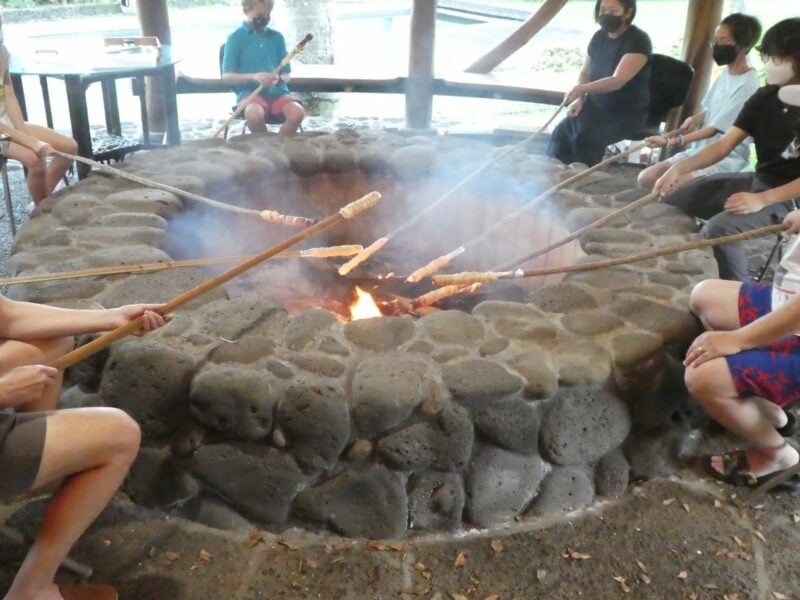
One of the tour options is roasting Baumstriezels (a delicious eastern European version of bread on a stick) over an open campfire.
Ranch Tour on a UTV
The Waipiʻo on Horseback Ranch spans a traditional land division (Ahupuaʻa) that stretches from the mountain to the ocean and is home to native flora and fauna.
You can explore their grounds with a 2.5 hour tour with a UTV during which you get to make 4 to 8 stops depending on the weather and condition of the trail. At every stop the local guides engage and talk about the ranch history, present planting projects, and the importance of the rich cultural landscape. There is a lot of history in this property and the guides giving the tours are very knowledgeable!
This is a great adventure if you are looking for an educational experience filled with beautiful views.
Explore Hawaii’s Rich Cultural Landscape on a UTV Farm Tour
A scenic UTV + Farm tour that takes you from fertile gardens and a working livestock ranch to sweeping grasslands, oceanfront, and tree canopies
from:
$150
What is a suggested tour?Our suggested tours are hand-picked tours that receive consistent good reviews, give back to the community, and work hard to minimize their impact on the environment. Read more about these tours on our website.Volcano Winery
This probably comes as a bit of a surprise but did you know that Hawaii has a winery?
The vineyards of the Volcano Winery are spread over the fertile volcanic slopes of Mauna Loa, close to the entrance of the Hawaii Volcanoes National Park. While they do not offer a tour of their vineyards they do offer tastings of their locally produced wines 🍷and teas.
Read more about the Volcano Winery (and the wine tasting) on our website.
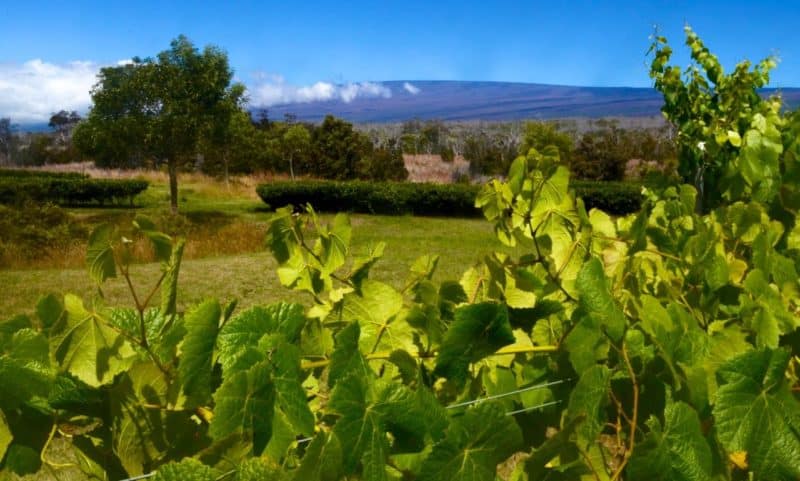
The Volcano Winery vineyard is located on the Mauna Loa volcano, which you can see in the background. Photo credits: Mike Neenan
Hibiscus Farm Tour
Almost everyone is familiar with the showy hibiscus flower, but did you know about the edible kind called Hibiscus Roselle?
Hawaiian B Farms is a lovely family farm outside of Honokaʻa that grows this edible hibiscus and offers 1.5 hour tours of both their greenhouse growing area and outside demonstration garden. During the tour you are guided through their estate greenhouse and outdoor exploration garden, and get to taste the intense flavors of fresh hibiscus along with their flowers in syrup, preserves and tea.
More details and booking information on the Hawaiian B Farm website.
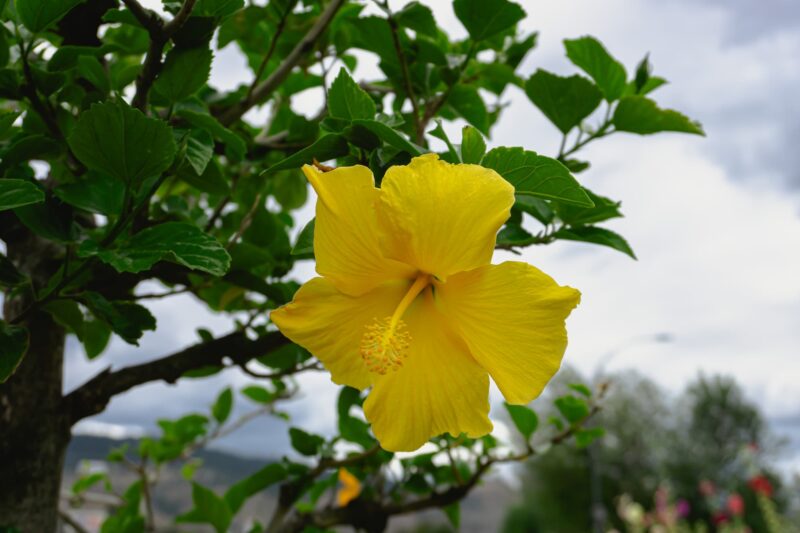
You can find Hibiscus flowers all over the Hawaiian islands – so much so that the yellow hibiscus is Hawaii’s state flower. Photo by Donna McL on Unsplash.
Petting zoo / Bee Tours / Animal Shelters:
We have a LOT of animal-related tours for you to pick from, ranging from small insects (beehives and honey production) to large (rescued) farm animals. You can also pay a visit to a petting zoo in Volcano or get some goat therapy in Honomu, tour an octopus and seahorse farm in Kona, take out a shelter dog for a day trip, and even get to see zebras and flamingos in an exotic animal shelter!
You can find the following tours in this section:
- Bee keeping tours
- Animal sanctuaries
- Petting zoo/farm
- Take a shelter dog out for the day
- Seahorse farm tour
- Octopus farm tour
- Coral lab tour
Bee Keeping tours
Bees play a large role in Hawaiian agriculture by pollinating local crops such as coffee, macadamia nuts, and many tropical fruits. Many of our bee colonies (1/3 of all colonies in the state) are located in the south Kona district, and Kealakekua bay is especially well-endowed when it comes to bees- it has one of the largest concentrations of honey bees in the pacific basin.
Bird and Bee Hawaiʻi (Honokaʻa)
Located on a small 5 acre farm in Honokaʻa, Bird and Bee Hawaiʻi organizes a 2-hour “Bee keeping introduction for visitors” tour of their farm and hives. You can read more about the tour on their website.
Big Island Bees
You can learn a lot of local bee-facts and of course about beekeeping by visiting the tour organized by Big Island Bees (book here directly), or see their website first), organized at their honey packing & processing plant. The super interesting tours include an inspection of a live hive with a beekeeper, which you can watch from behind a screened area, and a free sampling of all their different honey varietals. After the tour you can also have a look at their small museum and possible buy some of their products.
See the following video to get an idea of what the bee tour is like:
We’ll leave you with some interesting bee-facts to get started:
- Did you know that Hawaii has 62 (!) native bee species¹? All of these species derive from one common ancestor that crossed over from east Asia, but they have since spread over all island and diverged to pollinate our wildly different ecosystems.
- Native bee species are by the way not used for honey production. This honor goes to the honey bees, the first of which were introduced to the Hawaiian islands in 1857.
- The Hawaiian word for the native bees is nalo meli maole, which is derived from the words ‘nalo‘ (flying bug), ‘meli‘ (honey), and ‘maoli‘ (native).
See also this study or this article for a more thorough discussion on local bees.
¹: Daly and Magnacca 2003, Magnacca 2011.
Animal Sanctuaries
There are a few animal sanctuaries on the Big Island that take over the care of (exotic) animals when their owners can’t do so anymore. These sanctuaries organize tours during which you get to learn about, and interact with, the animals.
The following sanctuaries may be fun to visit if you are an (exotic) animal fan:
Magical Creatures Sanctuary
The Magical Creatures Sanctuary is a nonprofit Farm Animal Rescue and Sanctuary located on the beautiful Hamakua Coast. Many of their resident animals love attention and enjoy cuddles, but please remember this is not a petting zoo — all interactions are on the animal’s initiative.
You can visit the sanctuary for a tour but reservations in the form of a donation are required. This is an entirely volunteer run organization, so any donation you make goes directly to the animals.
During the tour, which last 2 hours, guests are taken from species to species and enter the pastures and yards with many of the sanctuary residents. You get to know the residents’ rescue stories, information about the various species of farmed animals, and the industries they came from. There are lots of opportunities throughout the tour for up-close interaction with the magical creatures.
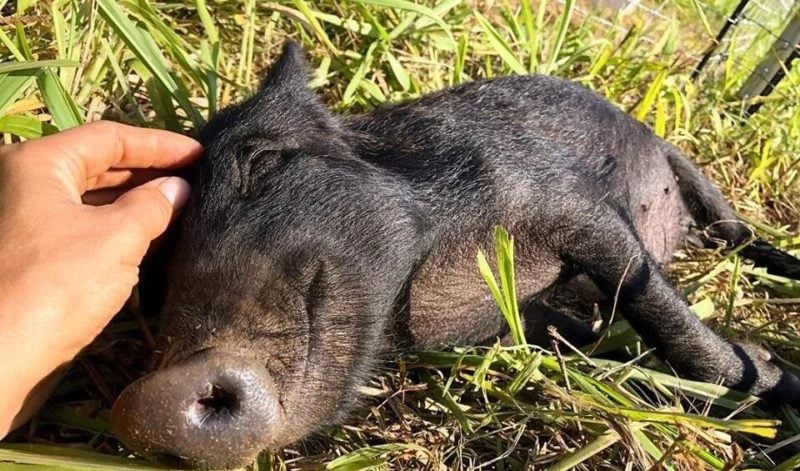
One of the animal sanctuary’s residents that LOVES cuddles. Image credit: Magical Creatures of Hamakua
Three Ring Farm
The Three Ring Farm (close to Kona) is Hawaiʻi’s only fully accredited, USDA licensed, exotic animal sanctuary. They are home to zebras, Hawaiian nene, iʻo (hawk), and pueo (owl), flamingos and reptiles, as well as many other rare, endangered and exotic creatures. The Sanctuary has no regular, open hours for the public but they do offer educational tours for small groups which last about two hours. These tours are an incredible close-up experience for children and adults to learn about the behavior and communication of the exotic animal residents and learn how they came to be here.
Big Island Farm Sanctuary (closed)
The Big Island Farm Sanctuary in Naalehu has permanently closed.
Parrots in Paradise
Parrots in Paradise in Kealakekua is a parrot rescue, rehabilitation, education and adoption center. These beautiful birds are not native to Hawaii but still the sanctuary managed to rescue over 80 friendly parrots. They organize ~2 hour tours during which you enjoy a guided walk around the sanctuary and get to know the range of personalities of cockatoos, lovebirds, macaws, and more species. Throughout the tour, you will have many photo opportunities with some of their best-trained parrots.
Krishna Cow Sanctuary
The Krishna Cow Sanctuary is currently home to over 60 bovines, including bull, steers, calves, and retired mother cows – mostly originating from the closure of Big Island Dairy in 2019. To cover part of their cost the sanctuary organizes “Cow Cuddle Experiences” where you can get up, close, and personal with the most lovable members of the herd. More details on on cow cuddling here.
Petting Zoos
The Lili House Farm (Volcano)
The Lili house farm is a small family farm with LOTS of animals in Volcano Village. The guided tour lasts between 1 and 1.5 hours and includes a walk through their farm as well as access to the petting zoo where you can hold, cuddle and feed the animals.
Ranch Tour and Animal Encounters – Ola Nani Ranch (Puna)
Get up close with alpacas, goats, sheep, horses, a giant tortoise named Herberto, and even a mini horse named Koa during this fun, hands-on ranch tour. Guests are encouraged to feed the animals in their habitats, snap selfies, and learn about their care. Seasonal fruit tastings and a guided walk-through of the farm make this an engaging experience for all ages.
More information and booking info on the Ola Nani Ranch website.
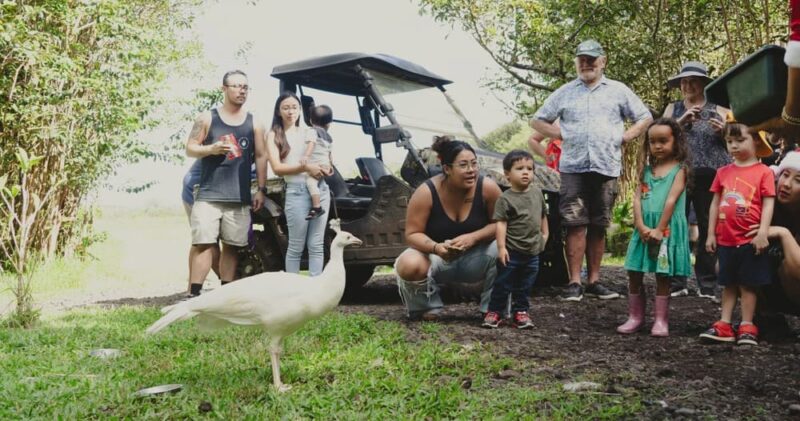
A family-friendly moment on the ranch tour at Ola Nani Farms, where guests of all ages can meet and feed animals like alpacas, goats, and peacocks.
Honomu Goat Dairy farm (Hamakua Coast)
Overlooking the ocean on the beautiful Hamakua coast, The Honomu Goat Dairy offers visitors Goat therapy and Goat yoga with their never-ending supply of baby goats. The charge a small fee for the 30-minute therapy session but you receive the amount you pay back in store credit to spend in their visitor shop where you can buy goat milk products, goods from local artists, or (more) goat treats.
Read more about goat therapy on the Honomu Goat Dairy website.
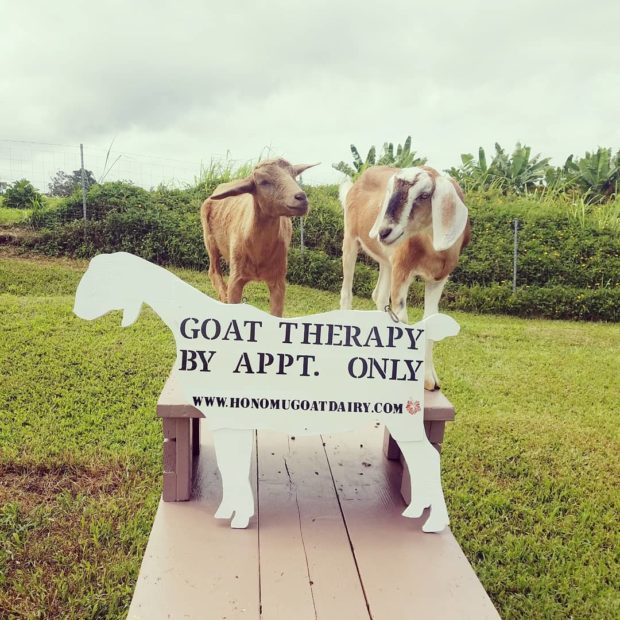
Goat therapy is currently by appointment only so make sure to check out the details on their website. Image credit: Honomu Goat Dairy.
Take a shelter dog out for the day
Did you know that the Hawaii Island Humane Society allows visitors to “check out” a dog for the day from our shelters?
The main goal of this program is for you to enjoy the Big Island and to get your “dog fix” by taking along one of their shelter dogs on your adventure. The shelter will ask you to fill out an evaluation on your return so that potential adopters will know more about the dog. Pictures are encouraged!
You can find out more about how you get to take a dog for a Hawaiian adventure on the Hawaii Island Humane Society website.
Visit an Octopus Farm
The Kanaloa Octopus Farm in Kona is technically a “cephalopod aquaculture research facility” which means you’ll get to learn cool science-y stuff! During the tour you will learn about octopuses (or is it octopi?), see them up close, and interact with them in their tank. All octopi on the farm are brought in by local fishermen, so they are basically rescues.
Read more about visiting the octopus farm on our website, or go directly to the Kanaloa Octopus Farm website
Visit a Seahorse Farm
The Ocean Rider Seahorse Farm in Kona raises seahorses in captivity to sell them to collectors. This greatly helps the ‘wild’ population of seahorses since it reduces the pressure on their population from hunting/capturing.
During the tour of the seahorse farm you get to see the now over 25 species of seahorses up close and personal, and there also is an interactive tide pool and a fish feeding station for the children available. All tours are led by a professional and certified Biologist that has been trained in public speaking.
You can read more about the tour on our website, or go directly to the ocean rider website.
Coral lab tours (by the Legacy Reef Foundation)
The Legacy Reef Foundation organizes tours at their facility two days per week that include a lecture by a marine scientist and a tour of their coral lab. The tour lasts approximately 90 minutes and you’ll get to learn all about coral – what it is, where it lives, how it feeds, the problems it’s currently dealing with in our oceans and what you can do to help.
More information at the Legacy Reef Foundation website.
Native trees / tree planting
Hawaiʻi Legacy Forest
Hawaiʻi’s Legacy Forests is restoring a historic forest on the slopes of Mauna Kea that once was the personal koa forest of King Kamehameha the Great to its original glory. Nearly a century ago this land was cleared to make room for farming and ranching and now over 400.000 new trees have been planted.
The tour consists of a ride into their growing forests to find a place to plant an endemic tree, during which your guide will tell you about the island flora and fauna, island history, and Hawaiian culture. The tree you plan is tagged with an Radio-frequency identification (RFID) chip which allows you to track its growth and look it up at later times.
Read more information on the Hawaiian Legacy Tours website.
Mamaki Forest Tour
Māmaki is a culturally significant plant native to the Hawaiian Islands whose leaves are made into tea or used as a medicine.
You can learn more about Māmaki with a tour to the the enchanted Māmaki forest in Volcano Village.During the tour you are taken through a forest farm as well as 29 acres of native Hawaiian rainforest by a guide that offers a deep knowledge of the forest, history of the site, native and invasive species, and farming and processing methods used to produce mamaki tea.
Visitors can pick mature māmaki leaves and see māmaki seedlings and plants at various stages of development, and tours customarily end with a tasting & blending experience on the Hawaii Forest Farm lanai.
Read more about this tour on the Hawaii Forest Farms website.
Farmers Markets
Farmers markets are one of the best places to find locally produced goodies, freshly prepared food (breakfast and lunch), and buy handmade souvenirs to take home. Also important: by buying directly from our farmers you cut out the middle man and help to strengthen the local community!
Most farmers markets are only open on one or two days of the week, but there are enough markets on the Big Island to make visiting one easy without compromising your itinerary.
You can find more information on our BIG list of Farmers Markets on the Big Island.
Farm to Table Restaurants
Farm-to-table is a way to say that the food on the table comes directly from a specific farm without going through a store, market, or distributor along the way.
In its purest form, farm-to-table means the table is actually at the farm and that the food you are being served is grown on the lands you are dining on. It is very rare, however, to find farms diverse enough to grow all the produce needed for a full meal, and a more common way to enjoy a farm-to-table dinner is at one of our local restaurants, where the chefs make sure to source as many of their ingredients as possible (ballpark 70 to 80%) directly from local farms.
Farm to Table Lunch / Dinner
Below is an incomplete list of places where you can enjoy delicious meals made with local ingredients:
- The Starseed Ranch offers farm-fresh dinners prepared in their open-air kitchen. You can find them in our list of general farm tours.
- The Laulima Food Patch in Kona serves authentic food made predominantly from local ingredients. This is not a sit-down restaurant, but they serve a small menu of pre-made dishes during daytime. Perfect for a quick stop (outdoor seating) or take-out.
- Pineapples is a family run open-air restaurant in downtown Hilo with occasional live music, good food, and great drinks/cocktails. Their dishes are locally inspired, and they source most of their ingredients from the island.
- Merriman’s in Waimea is one of the pioneers of the modern farm-to-table experience and has offered authentic Hawaiian cuisine for over 30 years. You can expect high quality and delicious food and wine, but the high and consistent quality come at a price. Pro tip for those of you traveling on a budget: the lunch menu is more affordable than the dinner menu.
Note that there are far more local restaurants with a sustainable approach to sourcing their ingredients on the Big Island. Just because they didn’t make it on our list doesn’t mean they are not worth a visit, and we’d LOVE to hear from you if you think we should add another restaurant or cafe to the list.
Farm to Table Cooking Class + Lunch
If you want to take the farm to table concept a bit further you can also harvest and prepare your own food. See for example the following 4-hour tour near Hilo that includes the harvesting, preparing *and* eating of a truly local lunch:
Farm-to-Table Cooking Class + Lunch at Kulaniapia Farms
Harvest fresh produce from the farm and prepare a plant-based meal together with this personal and authentic Farm-to-Table Cooking Class
from:
$149
What is a suggested tour?Our suggested tours are hand-picked tours that receive consistent good reviews, give back to the community, and work hard to minimize their impact on the environment. Read more about these tours on our website.The Imu Mea Ai Food Tour (Pahoa)
Imu mea ʻai means “cooked food from an underground oven”, and with this day-long experience you get to experience exactly this during an authentic Hawaiian culinary experience.
This tour is filled with filled with immersive cultural activities – here’s what you’ll experience:
- (7am) Oli, Chant, Protocol
- (8am) Prep and Install food in the Imu (underground oven)
- (9am) Gather materials for secondary Imu
- (10am) Build secondary Imu
- (11am) Cultural Workshop Lei Making,, Chanting, Huaka’i, Cultural Exchange
- (12pm) Un-install food from the Imu
- (1pm) Feast Luau
- (2pm) Takeaways, Debriefing and Surveys
- (3pm) Pau Hana End of Tour
Tours are organized twice a month, you can find more details and booking information on the event website. Note that at the moment this provider caters to larger groups.
Agri-Tourism on the Big Island: all kinds of farm tours
Eco-tourism is getting more and more popular with the current focus of the state of Hawaiʻi on sustainable development. Many of our farms have started to organize farm tours and tastings, and visiting these farms to see and learn how things are grown (and taste) is a great way to make a connection with our island!
You can read all about the different kinds of farm tours in the sections above, but if you made it all the way here we’d like to reward you with a quick summary of why farming is such a big thing on the island of Hawaiʻi:
Summary of agriculture on the Big Island
The Big Island is home to 8 out of the world’s 13 main climatic regions making it an agricultural paradise. We are worldwide leader in harvesting macadamia nuts and orchids for example, and are the only US state where vanilla, cacao, and coffee, are grown commercially. An incomplete lists of more of the delicious locally grown things you can find on the Big Island are: ginger, honey, coconuts, and exotic fruits like pineapple, papaya, mango, jackfruit, durian, rambutan, star fruit, cherimoya, figs, lychee, and dragon fruit.
To make more clear how important agriculture is here on the Big Island: Agriculture sales in the state of Hawaiʻi contribute $1.9 billion yearly to the economy, making it one of the state’s top industries (source: the University of Hawai‘i’s College of Tropical Agriculture and Human Resources (CTAHR). The Big Island plays a large part in this as we provide most of the agricultural lands (we are the biggest island, after all), see the map below for a quick summary of which crops are grown here:
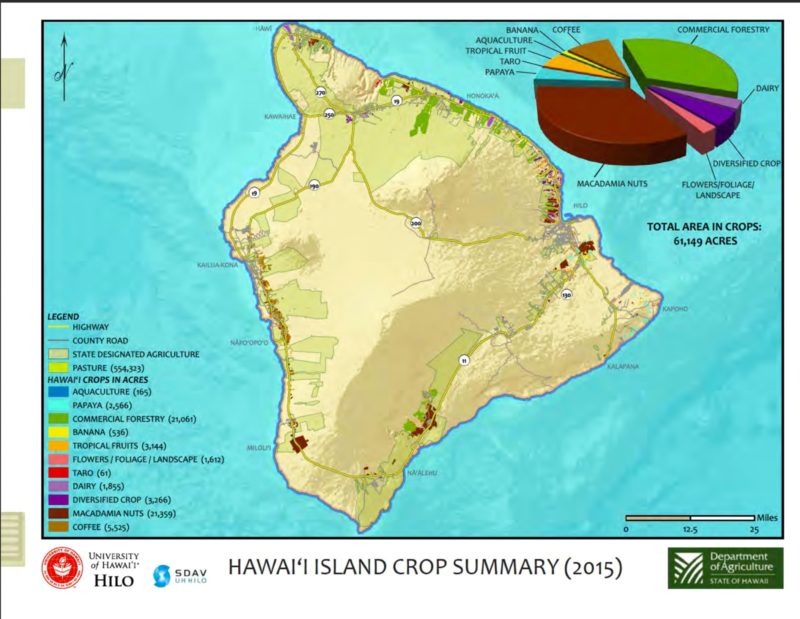
Summary of agricultural land use on Hawaii Island [source].
